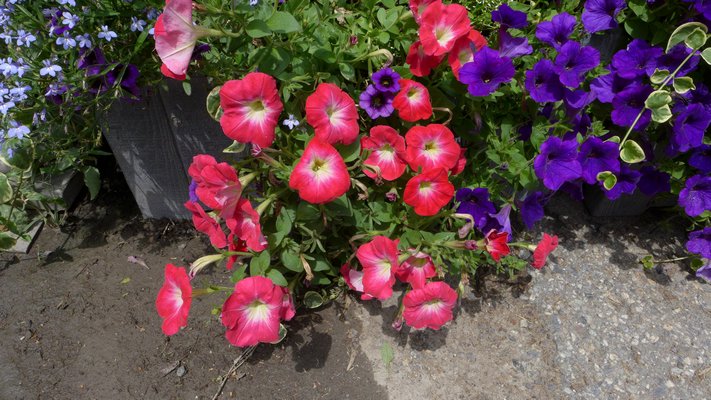

As we rush headlong into one of the lushest gardening seasons in years, for some reason I’ve got annuals on my mind. Now that’s pretty unusual since I don’t use annuals in my garden and yes, I have a well-known bias toward perennials. Nonetheless, annuals are a very important part of a well planned ornamental garden, especially if you expect it to be a garden that will continue to have color and excitement well into the dog days of July and August.Yes, the spring bulbs give us our first jolt and then the perennials gradually fill in. But unless you are the most talented and observant of gardeners, perennials have their weakness in that their prime displays peter off as summer builds and that’s where the annuals can fill the void, both literally and figuratively. And there’s a lot of sense in that when you consider that many of our traditional annuals have their heritage in the hotter growing areas like Mexico and the other central and South American countries as well as Africa and the Middle East.
In recent years, though, we’ve seen an infusion of other plant material that has confused the annual scene slightly, but this confusion is not necessarily bad. We’ve seen the introduction of the so-called “temperennials,” or perennials that don’t fit the definition since these perennials are also from further south and not hardy here. And we now use any number of tropical plants in our gardens and we treat them as annuals. I was actually surprised to be driving down a street recently where the front yard had been planted with banana trees. Even with global warming these are not yet hardy in our zone 7ish gardens.
But back to the annuals. We once considered these simply as plants that were seeded and flowered in a single growing season. At the end of the season, usually at the first hard frost, they are toast and never again to adorn the garden unless they are reseeded and started all over again, annually. The most notable and once the most popular garden annual is probably a tie between the marigold and petunia. They are seeded indoors in the winter, planted in late spring and when the going gets hot these southern natives give us spectacular and reliable blooms for one and up to three months. In nature, the non-hybrids would bloom prolifically and once they had produced seed the plants would die. Modern hybrids flower but don’t set seed. So they continue to flower until it just gets too cold for them to survive.
Another popular annual, the cosmos, is still considered an annual but it has a trick up its sleeve. It’s what we call a hardy annual. Huh? That doesn’t fit the definition that I just gave of annual. Here we have a plant that also thrives in the hot and dry days of summer, has its genetic roots from Mexico to Paraguay and yet gardeners swear to me that their cosmos return year after year and are therefore perennial. Well, they are half right. Some cosmos will return year after year but if you check carefully these plants don’t return from overwintering plants, they return from seed that was dropped the previous summer and germinated to grow a new annual. And since the seed survives the winter, we call them hardy annuals. A more common native plant that does this is our local jewelweed or Impatiens capensis, a true northern hardy annual.
Our newer garden annuals tend to be hybridized. This is done to create plants that have stable color, size and habits. The other benefit of these hybrids is that they are genetic mules, unable to reproduce. Sounds sad but it’s great for our gardens. Since they are not pushing all their energies into the production of seed, all the energy is put into flower production. The other benefit is that in open pollinated annuals—the ones that are not quite so reliable in terms of flower shape, color and size—if you allow them to go to seed they do just that, then die. Their genetically programmed work flow is done once seed has been set. The hybrids on the other hand, not setting seed, continue to flower as long as the environmental conditions like temperature, day length and nutrition are right.
It wasn’t that long ago that if you didn’t pinch the spent (faded) flowers from your petunias that they would just flower and the plants would fade away. Modern petunias now flower for weeks and months on end as long as they get watered and fed properly. Pinching them also serves the purpose of making them branch and thus become more prolific, but many of the newer varieties naturally branch as a genetic trait. You’ll also find many new traits with the modern hybrid marigolds, geraniums, impatiens, cosmos, begonias along with dozens of others.
One of the most amazing changes that plant breeders have done in recent years has been with what was once just a plant that your grandmother grew on her windowsill. The coleus. Yes, this too is an annual and one of the things your grandmother knew was not to ever, ever let her coleus flower because once it did, it was over. One trick she knew was to regularly take cuttings of her favorite plant because the rooted cuttings were the same as starting all over again and she would be sure to have another plant for several more months. In essence, she was cloning.
Most of the newer coleus however, are hybrids. Unlike our marigolds and petunias the newer coleus have been bred for their spectacular foliage colors and styles. Covering almost the entire color gamut with the exception of blue and with leaves as narrow as 1/4 up to 8 inches with edges smooth, scalloped and cut, this plant has been transformed into a garden performer that is simply spectacular and it adapts so well to shade and part shade. Few annuals can do this and none quite so well. But yes, coleus are still annuals and while you may not have to constantly pinch them to keep them from flowering and fading, they will indeed succumb to frost and cold.
Now there is one annual that I want to single out because I think it’s gone out of favor and I think it has so much to offer. It’s another one native to Mexico but because there are several short varieties and since it comes in blue the dwarf bedding types are a wonderful plant for edging the front of the hot summer border where the blue tends to give the border a cool and soothing effect. The plant is ageratum houstonianum and it can look absolutely stunning when mass planted or used as a wide edger. It needs good sunlight and in the heat of the summer it will need to be watered. There are varieties from the 3- to 5-inch dwarf bedders up to 30-inch types like Blue Horizon and there are also varieties in pink and white. And for a perennial snob, like yours truly, there is also a perennial white and blue ageratum that flowers in the fall. Ageratum can also make a nice cut flower and for this purpose look for taller varieties like Blue Bouquet.
Don’t forget that annuals are also an important part of any cutting garden. Here you’ll probably want a selection of tall zinnias, snapdragons, asters, larkspurs, stock, plumed celosia and gazanias to name just a few. Not too late to buy them in cell packs and pots and you can have flowers to cut in as little as three weeks. Keep growing.
 More Posts from Andrew Messinger
More Posts from Andrew Messinger